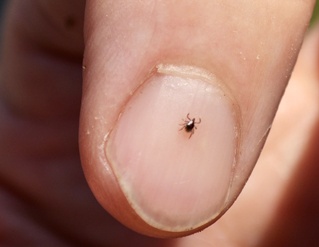Yale researchers identify extent of new tick-borne infection
10 May 2014
The frequency of a new tick-borne infection that shares many similarities with Lyme disease, and a description of the antibody test used to test individuals for evidence of the infection, have been reported for the first time by researchers at the Yale Schools of Public Health and Medicine. The results are published in the May 7 online issue of Emerging Infectious Diseases.
 The new antibody test was used to detect evidence of infection by the bacterium Borrelia miyamotoi, which is found in black-legged ticks and is related to the Borrelia (a bacteria sub-type) that causes Lyme disease. The researchers found that about 4 per cent of 639 healthy people living in southern New England had evidence of previous B. miyamotoi infection, compared to about 10 per cent with evidence of previous Lyme disease infection.
The new antibody test was used to detect evidence of infection by the bacterium Borrelia miyamotoi, which is found in black-legged ticks and is related to the Borrelia (a bacteria sub-type) that causes Lyme disease. The researchers found that about 4 per cent of 639 healthy people living in southern New England had evidence of previous B. miyamotoi infection, compared to about 10 per cent with evidence of previous Lyme disease infection.
In addition to concluding that human B. miyamotoi infection may be common in southern New England, the authors also write that the antibody test for Borrelia burgdorferi, the agent that causes Lyme disease, is not an effective tool for detecting the newly identified infection.
Although the two bacteria share some common characteristics, they are different enough that the new test described in the report in Emerging Infectious Diseases is needed for detection of antibody to B. miyamotoi.
''Although not as common as Lyme disease, the frequency of B. miyamotoi infection in southern New England appears to be comparable to that of other infections transmitted by the black-legged tick, such as anaplasmosis and babesiosis,'' said Dr. Peter Krause, senior research scientist at the Yale School of Public Health and lead author of the study.
Many symptoms are similar to those of Lyme disease, but patients with B. miyamotoi infection also may experience relapsing fever. People with a compromised immune system, such as cancer patients who are receiving chemotherapy, may develop B. miyamotoi meningitis. Antibiotic treatment for the newly discovered infection should be the same as for Lyme disease, Krause said.
All patients in the study were from the Northeast, but researchers believe cases may occur in other areas of the country where Lyme disease is endemic because the bacterium has been found in 2 per cent to 10 per cent of all ticks that transmit Lyme disease.
Durland Fish, professor of epidemiology at the School of Public Health and the study's senior author, discovered the bacterium in black-legged ticks from Connecticut more than a decade ago. In 2011, he and Krause were coauthors on the first published report of human infection. The current study was designed to begin to determine how frequently human infection occurs in the United States.
Other authors include Erol Fikrig, chief of infectious diseases at Yale School of Medicine; Sukanya Narasimhan, research scientist in infectious diseases at the Yale School of Medicine; Gary P. Wormser at New York Medical College; and Alan G. Barbour at the University of California-Irvine.













.jpg)






.jpg)









